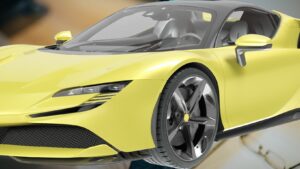Tesla’s electric cars are turning heads, not just for their sleek design and impressive performance, but also for their potential to redefine sustainability in the automotive industry. As the world grapples with climate change, Tesla’s commitment to environmental conservation is more relevant than ever.
But just how sustainable are Tesla cars? This article dives into the heart of the matter, examining the environmental footprint of these innovative vehicles, from production to disposal. We’ll explore how Tesla’s unique approach to design, manufacturing, and energy consumption is shaping the future of sustainable transportation.
Sustainability of Tesla Cars
 Tesla stands firm in its mission of accelerating the advent of sustainable transport. An integral part of its corporate policy aims to lessen the environmental impact of its operations. It channels its efforts into two key areas: energy efficiency of the Tesla vehicles and use of sustainable materials.
Tesla stands firm in its mission of accelerating the advent of sustainable transport. An integral part of its corporate policy aims to lessen the environmental impact of its operations. It channels its efforts into two key areas: energy efficiency of the Tesla vehicles and use of sustainable materials.
Tesla cars’ energy efficiency models a revolutionary way for automobiles. Traditional gasoline cars convert about 17% to 21% of the energy stored in gasoline to power at the wheels, as reported by the U.S. Department of Energy. Tesla vehicles, in contrast, convert over 60% of electrical energy from the grid to power at the wheels.
Interestingly, Tesla’s energy efficiency doesn’t stop at the cars’ functionality. Tesla’s Supercharger network, a global charging infrastructure, is designed to minimize energy loss during charging. The use of a unique connector, chargers that bypass onboard charging equipment, and batteries that accept direct current ensure efficient energy transfer, bringing about considerable improvements in charging times.
Use of Sustainable Materials
 Tesla’s commitment to sustainability mirrors in its use of eco-friendly materials. In the Model S, for example, Tesla has replaced traditional lead-acid batteries with a lithium-ion battery. Lithium-ion batteries, while more expensive, are known for their longevity and efficiency, which translates to less frequent replacements and a reduced environmental footprint. Furthermore, Tesla’s seat covers in the Model S and X are made from a synthetic material, avoiding the use of leather. This decision beefs up sustainability by reducing demand for cattle farming, a known contributor to deforestation and greenhouse gas emissions.
Tesla’s commitment to sustainability mirrors in its use of eco-friendly materials. In the Model S, for example, Tesla has replaced traditional lead-acid batteries with a lithium-ion battery. Lithium-ion batteries, while more expensive, are known for their longevity and efficiency, which translates to less frequent replacements and a reduced environmental footprint. Furthermore, Tesla’s seat covers in the Model S and X are made from a synthetic material, avoiding the use of leather. This decision beefs up sustainability by reducing demand for cattle farming, a known contributor to deforestation and greenhouse gas emissions.
Moving forward, Tesla continues to explore recycling and second-life applications for its lithium-ion batteries. It’s an unyielding approach that reinforces their commitment to reduce, reuse, and recycle, exemplifying sustainability throughout the vehicle’s lifespan.
Innovations in Battery Technology
 Building on Tesla’s overarching approach to sustainability, let’s delve into specifics, exploring how advancements in battery technology contribute to these efforts. Tesla’s battery technology has seen significant improvements over the years, leading to amped-up energy efficiency. It sports Lithium-ion batteries, a type known for its long life and high charge storage capacity. For instance, the Model S Long Range variant brings a breakthrough with a range of 370 miles on a single charge, substantiating Tesla’s strive for constant evolution. Cybertruck, in its Tri Motor AWD variant, promises an even more impressive range of over 500 miles. Consistent enhancements in the design and composition of the batteries ensure they serve their purpose in the vehicle for longer periods, minimizing the frequency of replacements.
Building on Tesla’s overarching approach to sustainability, let’s delve into specifics, exploring how advancements in battery technology contribute to these efforts. Tesla’s battery technology has seen significant improvements over the years, leading to amped-up energy efficiency. It sports Lithium-ion batteries, a type known for its long life and high charge storage capacity. For instance, the Model S Long Range variant brings a breakthrough with a range of 370 miles on a single charge, substantiating Tesla’s strive for constant evolution. Cybertruck, in its Tri Motor AWD variant, promises an even more impressive range of over 500 miles. Consistent enhancements in the design and composition of the batteries ensure they serve their purpose in the vehicle for longer periods, minimizing the frequency of replacements.
Recycling and Repurposing of Tesla Batteries
Aligned with its sustainability objectives, Tesla demonstrates an active role in recycling and repurposing spent batteries, emphasizing its commitment to a cradle-to-grave—better yet, cradle-to-cradle—philosophy. Tesla not only designs its batteries for efficiency but also for an afterlife. It’s partnered with recycling companies like Umicore to recycle used lithium-ion batteries into reusable components. The process mitigates waste and reduces the need for fresh lithium mining, underscoring Tesla’s comprehensive approach to battery life-cycle management. The reusable materials extracted from spent batteries embark on a new life, shaping up products that demand less intensive manufacturing processes. With every recycled battery, Tesla makes a step towards a more sustainable and eco-friendly future.
Pioneering solutions through solar power contributes to Tesla’s new-age energy ecosystem. This section emphasizes Tesla’s role in integrating renewable energy, with focus on grid contributions and energy storage advancements.



